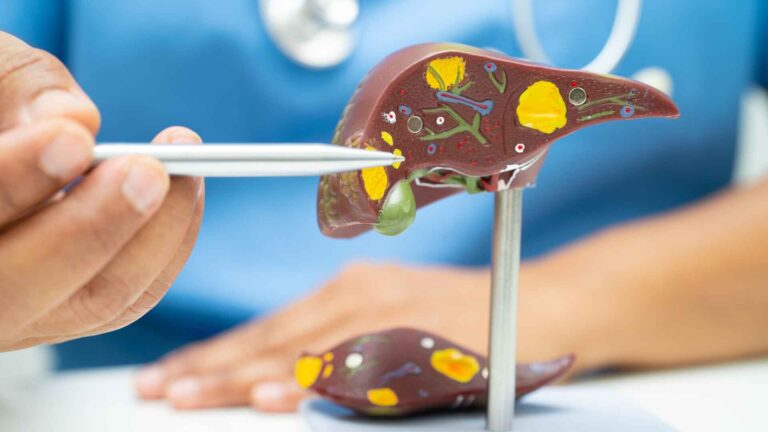Fatty liver disease is rapidly growing to become a global epidemic and has been causing harm to millions of individuals of all ages. As of 2025, the cases of the classroom with a diagnosis continue to increase because of lifestyle choices that include improper food consumption, obesity, and physical inactivity. Now more than ever, it is necessary to know the causes, symptoms and the latest treatment of fatty liver disease.
This paper will go in detail to discuss the kinds of fatty liver disease, such as non-alcoholic fatty liver disease (NAFLD) and alcoholic fatty liver disease, the most common symptoms, and the latest and most effective treatment choices on the market in 2025.
What is Fatty Liver Disease?
Fatty liver disease is a disease in which fat accumulates in the liver. Although it is normal to have some fat in the liver, once it constitutes above 5-10 percent of the liver mass, fat may result in liver inflammation and subsequent destruction of the liver in the long term.
There are two main types:
Non-Alcoholic Fatty Liver Disease (NAFLD): This is a disease that is present among individuals who consume alcohol in minimal or no amounts. It is the prevalent liver disease in the world particularly in obese, diabetic, or metabolic syndrome patients.
Alcoholic Fatty Liver Disease (AFLD): It is a disease that is caused by too much alcohol. Prolonged alcoholism may result in further serious liver problems like alcoholic hepatitis and cirrhosis.
Fatty Liver Causes in 2025
The etiological factors of fatty liver disease in 2025 remain consistent with lifestyle and metabolic problems:
Obesity and Overweight: This is one of the primary risk factors because the fat is built up in the liver.
Improper Diet: Unhealthy fat diets, high sugar levels and processed foods lead to fat deposition in the liver.
Type 2 Diabetes and Insulin Resistance: Close association with NAFLD.
High Cholesterol and Triglycerides: Can elevate the level of fat in the liver.
Alcohol Consumption: Over drinking is one of the major causes of NAFLD.
Sedentary Lifestyle- Exercise is also a contributing factor to obesity because it decelerates metabolism and triggers fat deposition within the body.
Genetic Factors: There are those that are predisposed to fatty liver disease genetically.
Common Fatty Liver Symptoms
The symptoms of Fatty liver disease are usually silent in the initial stages. Nevertheless, with the course of the disease, one can experience:
- Fatigue or weakness
- Abdominal pain in the upper right or discomfort.
- Unexplained weight loss
- Large liver (hepatomegaly)
- Increased liver enzymes (detected by blood tests)
- Nausea or poor appetite
- Jaundice (in severe cases)
The disease can be managed through early detection thus it can be prevented before progressing to non-alcoholic steatohepatitis (NASH), cirrhosis, or even liver cancer.
Diagnosis of Fatty Liver Disease.
In 2025, modern diagnostic resources have enhanced the early diagnosis of fatty liver:
Blood Test: To examine the liver enzymes and eliminate other causes.
Ultrasound/FibroScan: Non-invasive to identify liver fat and stiffness.
MRI, CT Scans: Detailed images of the liver.
Liver Biopsy: There are instances where a sample can be obtained to determine inflammation and scarring.
It is highly advisable to monitor liver health by conducting regular checkups and frequent liver health screenings on people who are at risk.
The Future of Fatty Liver Treatment in 2025.
With the development of medicine, treatment of Fatty liver disease in 2025 will be more individual and effective than ever before:
Lifestyle Interventions (First line of treatment)
Weight Loss: This is because losing 7-10% of body weight can help dramatically cut liver fat.
Healthy Diet: Low-carb diets and the Mediterranean diet are known to enhance the performance of the liver.
Exercise: Liver fat is minimized by regular aerobic and resistance training.
Drugs (Under Clinical Use and Development)
GLP-1 Receptor Agonists (e.g., Semaglutide): This was originally used to treat diabetes, but is currently showing promise in NAFLD treatment.
Pioglitazone and Metformin: These are used in cases of insulin resistance; they are promising in reducing fatty liver.
Re-Trials in 2025: There are a few pharmaceutical companies developing liver-specific drugs against inflammation and fibrosis.
Liver Detox & Supplements
- Milk Thistle, Vitamin E, and Omega-3 Fatty Acids have exhibited a possibility in helping liver health.
- They should however be taken under medical guidance.
Complex Treatment (In severe cases)
- Liver transplant can be required in cirrhosis, or liver failure.
- Less invasive surgical procedures that are endoscopic bariatric are also being considered in treating obese individuals with fatty liver.
Prevention of Fatty liver disease.
It is easier to prevent fatty liver than to treat it. Some of the major prevention measures are:
- Eating well to remain slim.
- Restricting the consumption of sugar and processed food.
- Avoiding excessive alcohol
- Exercising (150 minutes/week of moderate exercise)
- Treatment of cholesterol, high blood pressure and blood sugar.
- Having frequent liver health screenings.
Conclusion
Fatty liver disease is a health condition that is increasingly becoming a health concern in the year 2025 yet early diagnosis and new treatments are enabling people to live healthy lives and have longer lives. The number of choices available to control and even reverse this condition has never been greater than the number of lifestyle changes and other advanced medical therapies.
You may have just been diagnosed or are managing a long-term case, or you are just trying to prevent fatty liver; whatever the case may be, you need to keep up with the times, make well-informed lifestyle decisions, and see the healthcare providers to have personalized care. A healthy liver is an achievement that is attained with the correct moves.



1 Comment
Pingback: NBC Vaccine Divide | Reactions to Vaccine Coverage